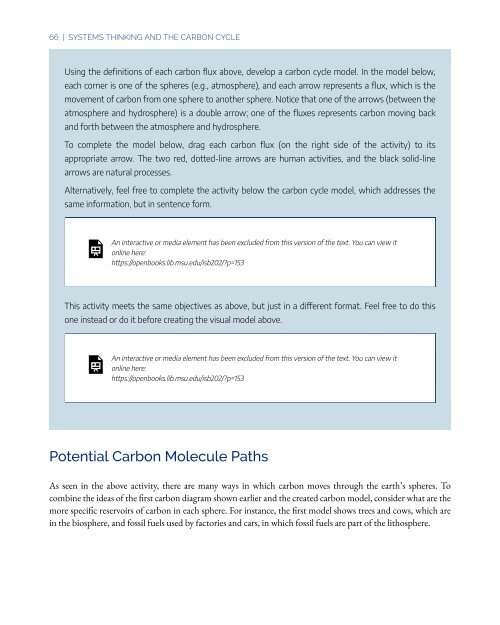An Interactive Introduction to Organismal and Molecular Biology, 2021
An Interactive Introduction to Organismal and Molecular Biology, 2021
An Interactive Introduction to Organismal and Molecular Biology, 2021
You also want an ePaper? Increase the reach of your titles
YUMPU automatically turns print PDFs into web optimized ePapers that Google loves.
66 | SYSTEMS THINKING AND THE CARBON CYCLE<br />
Using the definitions of each carbon flux above, develop a carbon cycle model. In the model below,<br />
each corner is one of the spheres (e.g., atmosphere), <strong>and</strong> each arrow represents a flux, which is the<br />
movement of carbon from one sphere <strong>to</strong> another sphere. Notice that one of the arrows (between the<br />
atmosphere <strong>and</strong> hydrosphere) is a double arrow; one of the fluxes represents carbon moving back<br />
<strong>and</strong> forth between the atmosphere <strong>and</strong> hydrosphere.<br />
To complete the model below, drag each carbon flux (on the right side of the activity) <strong>to</strong> its<br />
appropriate arrow. The two red, dotted-line arrows are human activities, <strong>and</strong> the black solid-line<br />
arrows are natural processes.<br />
Alternatively, feel free <strong>to</strong> complete the activity below the carbon cycle model, which addresses the<br />
same information, but in sentence form.<br />
<strong>An</strong> interactive or media element has been excluded from this version of the text. You can view it<br />
online here:<br />
https://openbooks.lib.msu.edu/isb202/?p=153<br />
This activity meets the same objectives as above, but just in a different format. Feel free <strong>to</strong> do this<br />
one instead or do it before creating the visual model above.<br />
<strong>An</strong> interactive or media element has been excluded from this version of the text. You can view it<br />
online here:<br />
https://openbooks.lib.msu.edu/isb202/?p=153<br />
Potential Carbon Molecule Paths<br />
As seen in the above activity, there are many ways in which carbon moves through the earth’s spheres. To<br />
combine the ideas of the first carbon diagram shown earlier <strong>and</strong> the created carbon model, consider what are the<br />
more specific reservoirs of carbon in each sphere. For instance, the first model shows trees <strong>and</strong> cows, which are<br />
in the biosphere, <strong>and</strong> fossil fuels used by fac<strong>to</strong>ries <strong>and</strong> cars, in which fossil fuels are part of the lithosphere.


















